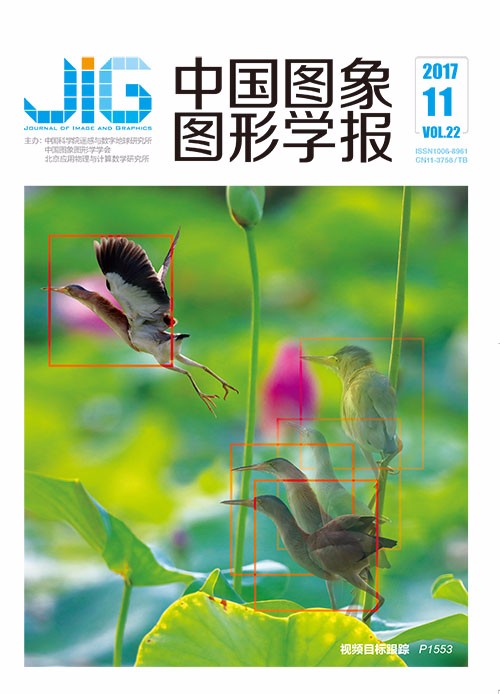
双空间局部方向模式的人脸识别
摘 要
目的 针对传统局部方向模式(LDP)在特征提取的充分性、对光照和噪声等的鲁棒性以及识别时间长短这3方面不能同时取得一个很好的平衡效果,提出了一种双空间局部方向模式(DSLDP)的人脸识别方法。方法 首先,将图像3×3邻域像素灰度值与8个Kirsch模板算子卷积,得到8个方向的边缘响应值,然后,将近邻边缘响应值之间相应作差,对应8个方向的边缘响应差值,将两组值取绝对值,取各自最大值的方向编码成一个二位八进制数,产生DSLDP码。最后,在人脸描述阶段将人脸图像进行分块并把每块转换成DSLDP图,再对DSLDP图进行直方图统计,并利用信息熵对每块进行加权,将所有子块的直方图连接生成人脸特征,再通过PCA进行降维,用最近邻分类器分类识别。结果 在剑桥大学Olivetti实验室(ORL)、Aleix Martinez and Robert Benavente (AR)和中国科学院(CAS-PEAL)的人脸图像数据库进行实验,相比局部方向模式(LDP)、显著型局部方向模式(SLDP)、增强型局部方向模式(ELDP)、局部方向数字模式(LDN)、差值型局部方向模式(DLDP)、中心对称局部方向模式(CSLDP)和梯度中心对称局部方向模式(GCSLDP),DSLDP具有更好的识别性能。5幅测试样本时,在ORL库上取得了97.82%的平均识别率,在AR光照、表情、遮挡A和遮挡B库分别取得了98.00%、98.33%、99.33%、87.67%的平均识别率,在CAS-PEAL光照、表情和饰物库分别取得了99.33%、95.33%、90.00%的平均识别率。结论 1)该方法既考虑了近邻边缘响应值的外在变化,也考虑了近邻边缘响应值之间的内在变化,通过将强度空间和梯度空间人脸特征信息结合使人脸特征得到更加充分的提取。2) DSLDP只考虑邻边缘响应值和边缘响应差值的最大值情况,突出了主要边缘梯度信息,同时又避免了不重要信息的干扰,相比同类基于局部方向模式的单一人脸识别算法,对光照、表情、噪声、遮挡等情况表现出更强的鲁棒性。3) DSLDP码是由二位八进制数构成,特征模式数降低到64,识别时间明显降低。因此,DSLDP算法能同时在识别效果,稳定性和识别时间上取得一个较好的平衡效果。
关键词
Face recognition based on double-space local directional pattern
Yang Huixian1, Liu Jian1, Zhang Mengjuan1, Zhou Tongtong2(1.Physics and Optoelectronic Engineering College,Xiangtan University,Xiangtan 411105,China;2.Mechanical and Electrical Engineering College,Hunan Institute of Applied Technology,Changde 415000,China) Abstract
Objective The rapid development of face recognition has made obtaining face feature information a major research area.Local feature representation can depict the local feature information of the face in much detail.Therefore,local feature representation is widely applied in facial feature extraction.At present,the local binary pattern algorithm is the most widely used.However,LBP still exhibits some defects that are insensitive to illumination changes and noise.The local directional pattern algorithm obtains the edge gradient value by convolving the local neighborhood,which is more stable than pixel value of LBP.LDP has more advantages than those of LBP.Therefore,LDP is developing rapidly in recent years.However,the traditional LDP algorithm cannot exert a good equilibrium effect on three aspects,i.e.,sufficient feature extraction,robustness to noise and illumination,and short recognition time,at the same time.This study presents a novel approach based on double-space local directional pattern (DSLDP) algorithm for face recognition to solve the previously mentioned problems.The DSLDP algorithm can exert a good balance effect on three aspects,i.e.,feature extraction,stability,and recognition time.Method First,each 3×3 neighborhood pixel of the facial image gains eight edge response values by convolving the local neighborhood with eight Kirsch template operators.Eight Kirsch masks represent the eight directions of the eight sides,i.e.,east,west,south,and north corresponding to the linear edge and northeast,northwest,southwest,and southeast corresponding to the line edge.Then,the difference of each pair of neighboring edge response values is calculated to form eight new difference directions.DSLDP utilizes the direction of the largest absolute value edge gradient value of each sub-neighborhood.The two directions are encoded into a double-digit octal number to produce the DSLDP code.Finally,the face descriptor is represented using the global concatenated histogram based on the DSLDP map extracted from the face image,which is divided into several sub-blocks.Sub-blocks are weighted by information entropy.The face dimensions are reduced by principal component analysis.The nearest neighbor classifier is used to classify the faces.Then,the identification results are obtained.Result The face representation method is compared with recently developed algorithms,such as LDP,significance local directional patterns,enhanced local directional patterns,local directional number patterns,difference local directional patterns,center of symmetry local directional patterns,and gradient center of symmetry local directional patterns.The experimental results of the ORL,AR,and CAS-PEAL face databases show that the DSLDP algorithm exhibits better recognition performance than that of the other algorithms.The average recognition rate of the DSLDP algorithm is 97.82% on the ORL database with five test samples.The average recognition rate of the DSLDP algorithm on the AR illumination,expression,shelter A,and shelter B databases are 98.00%,98.33%,99.33%,and 98.33%,respectively.The average recognition rate of the DSLDP algorithm on the CAS-PEAL illumination,expression,shelter databases are 99.33%,95.33%,and 90.00%,respectively.Conclusion 1) In the aspect of face feature extraction,the method considers not only the change in the inner edge response values but also the change in the outer edge response values.The method also fully utilizes face information extracted in the strength and the gradient spaces.2) In terms of stability,compared with other single face recognition algorithms based on LDP,the DSLDP algorithm only considers the maximum of edge response and difference edge response values.The DSLDP algorithm highlights the main edge gradient information and avoids the interference of unimportant information.Therefore,the algorithm shows strong robustness to the variations in posture,illumination,noise,and facial expression.3) In terms of recognition time,the DSLDP code is made up of a double-digit octal number;thus,the feature model number is reduced to 64 and the recognition time is obviously decreased.Therefore,the LDP algorithm can exert a good balance effect on three aspects,i.e.,face feature extraction,stability/robustness,and recognition time,at the same time.The algorithm is proved to be effective.
Keywords
local directional pattern double space local directional pattern kirsch operator information entropy principal components analysis nearest neighbor classifier face recognition
|



 中国图象图形学报 │ 京ICP备05080539号-4 │ 本系统由
中国图象图形学报 │ 京ICP备05080539号-4 │ 本系统由